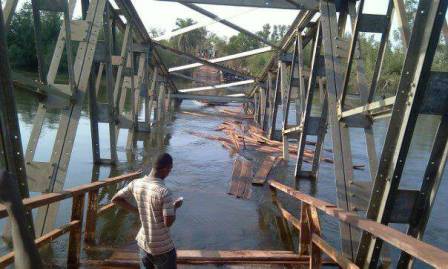Sierra Leone’s Works Minister clarifies Mabang Bridge’s funding by EU
Sierra Leone’s Minister of Works and Infrastructure, Hon. Alimamy P. Koroma (in photo) has informed this writer that funds for the construction of the collapsed Mabang bridge in the Moyamba districts “were made available to us (government) by the European Union this month (February )” and that “it was our government (current government) that negotiated for the funds” He spoke during a telephone interview on Wednesday 27th February, when he was contacted to clarify issues of funding for the construction of the bridge and other bridges including the Magbele bridge in the north of Sierra Leone.
Few days ago, precisely on the 22nd February 2013, the Mabang Bridge in the Moyamba district collapsed when a six-wheeler truck was reportedly crossing the bridge. Nobody was said to have died. This promptly caught the greatest attention of the President Ernest Koroma led government, as was seen in the high powered delegation that went on a fact finding mission, to the collapsed bridge. The delegation itself included the Hon. Vice President, Sam Sumana, Minister of Works, A. P Koroma, Minister of Information and Communications, Hon Alpha Kanu and the Director General of the Sierra Leone Roads Authority, Munda Rogers, amongst others.
Speaking on the phone, Minister Alimamy Koroma said “the funds were approved by the European Union two weeks ago and our government negotiated for funding for the three bridges…” He said, the forty million Euros approved by EU will cover the fixing of the Moyamba-Moyamba Junction Road and Magbele, Mabang and Gbangbama bridges, contrary to claims, forty million Euros have been slated for the Mabang bridge alone “If anybody is in doubt as to when the funds were approved, let them check with the EU”, he said confidently.
According to Minister Koroma, the prompt action taken by government is an indication that the government cares about the welfare of the people. When pressed on timeline for the completion of the project, he said, “We are fast tracking the process given what we are confronted with at the moment. But we are very much concerned about the welfare of our people”, he said over the phone.
Earlier, in a television interview on SLBC following the collapse of the bridge, the Director General of the SLRA, Munda Rogers informed the world, that the EU has made available 10 million Euros for the construction of the Mabang Bridge, and that the time the bridge collapsed coincided with the approval of the funds. The bridge, he then informed was only meant for lightweight vehicles and pedestrians but that some drivers ignored the warnings issued by SLRA which eventually caused the collapsed of the bridge.
Since elected into office in 2007, President Ernest Bai Koroma has paid utmost attention to the area of infrastructural development. He was elected into governance at a time when the country’s infrastructure was in an unacceptable state. There also was no sense of urgency in relation to the maintenance, rehabilitation or construction of roads. Work on the few roads marked for rehabilitation or social infrastructure projects by 2007 moved at a very slow pace or had completely stalled as a result of the contracts been badly awarded and executed. It was in a bid to address the situation, that his government, listed infrastructural development as a priority area in the Agenda for Change. And in the first term in of his governance, President Koroma succeeded in rolling -out the largest road construction programme ever in the history of the country. This was particularly so in the areas of ensuring an encouraging road network in terms of linking cities, towns and villages and in the areas of social infrastructure: which was aimed at meeting basic needs of Sierra Leoneans.
Roads were being constructed, reconstructed and rehabilitated in every region and district, thus connecting people and opening up the country to every Sierra Leonean. By March 2008, for example, which was barely 6 months in office, the government commenced work on two major trunk roads: the Makeni – Matotoka Highway (35 Km) and the Bo-Kenema Highway (65Km) with joint funding from the World Bank and GoSL. Both were completed in October 2009 and February 2010 respectively, as was also seen in a number of infrastructural projects across the country. The Agenda for Prosperity, which is the country’s blueprint for national development, also pays attention to the aspect of infrastructure.
Stay with Sierra Express Media, for your trusted place in news!
© 2013, https:. All rights reserved.



